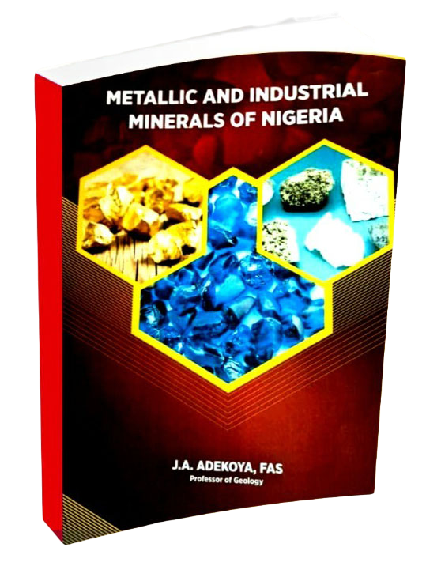The book is divided into seven major sections: An introduction in part 1 followed by part 2 on metallic minerals, part 3 on silicate industrial minerals, part 4 on non-silicate minerals; part 5 on carbonaceous minerals; part 6 on hydrocarbons and the final section in part 7 dedicated to socio-economic and environmental aspects.
The first part of the book – part 1 with two chapters gave a general overview of the regional geological framework of Nigeria within the larger West African sub-region with the highlights of rock associations of the Pre-Cambrian to Lower Paleozoic basement rocks and the sedimentary rock associations in the Cretaceous to Tertiary basins. A broad classification of all mineral resources consisting of the metallic and non-metallic (silicate and non-silicate industrial minerals) was made in this part of the book with the prominent minerals listed to set the stage for further detailed descriptions.
Part 2 of the book consists of six chapters. In this section, the author gave very lucid, succinct, and advanced knowledge of metallic minerals in Nigeria. Deposits of iron, ferro-alloy metals, tin and aluminum, lead-zinc, gold and silver, uranium, and associated metals were described in separate chapters. Aspects of their occurrences and distribution in their local geological settings, nature, styles, and controls of mineralization, deposit types, quality and quantity (reserves) where available, and thoughts on origin including comparisons with local and global analogs were done. The book contains enormous details of field descriptions of each deposit type, together with results of laboratory studies, mineralogical and geochemical with the appropriate citation of relevant references.
Contents for the part 3 section on silicate industrial minerals include six chapters subdivided into silica deposits, feldspars, clays and micas, refractory silicates, gemstones, construction stones, and weathering products. Each commodity is treated in a full chapter of its own respectively. The chapters are organized to emphasize the locations, quantity and quality, and geological controls of the resource, their utilitarian values, and aesthetics. The non-silicate industrial minerals are described in part 4. This section gave a comprehensive detail of the group of industrial minerals in seven chapters, namely: limestone deposits, marble deposits; gypsum occurrences; brines and evaporite occurrences; phosphates, barites and fluorite, and mineral pigment occurrences. These resources are organized with respect to their locations and geological settings including their salient petrographic and mineralogical characteristics, environments of deposition, and quantity and quality of the resource. The author provided geological maps and lithologic sections for worked deposits and excellent photographs of those currently worked by local artisans in the minefields.
Part 5 section of the book is dedicated to descriptions and assessments of the principal carbonaceous class of energy minerals in two chapters: coals and graphite, and lignites. The author provided data on the stratigraphic settings of the different ranks of coals and lignites with an emphasis on quantity, quality, and potential utilization. This is followed by a part 6 section consisting of two chapters dedicated to tar sands and oil and gas resources with an overview of the commodity aspects, geologic setting, properties, resource evaluation, and potentials of these resources in the inland frontier basins and the prolific Niger Delta oil and gas province. An account of the hydrocarbon potentials of the petroliferous basins is provided with illustrations of the elements of the petroleum systems.
Part 7 of the book on the socio-economic and environmental aspects is subdivided into three chapters. This part outlined the industrial application of each of the minerals; the contributions of the mineral sector to the economy; and aspects of the challenges facing the mineral industry including the environmental aspects. Some recommendations are put forward for the future advancement of exploration, and mining including mitigation measures and remediation of minefields for sustainable development. An appendix consisting of three sections is also provided for the locations of the mineral resources, occurrences, and prospects for easy reference.
All sections of this new book contain a lot of information, illustrations, and excellent photographs of key localities contributed directly from the author’s work together with his students and associates with appropriate referencing. The contents as packaged contain information that could not be easily found elsewhere having been put together from several years of research investigations, inquisitiveness, and innovation of the author complemented with information from colleagues who have reported some published works on specific minerals.


Reviews
There are no reviews yet.